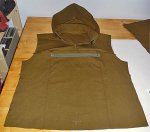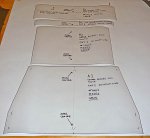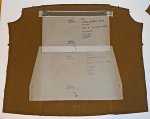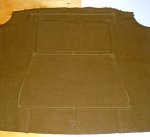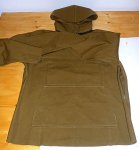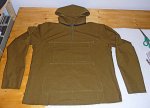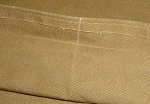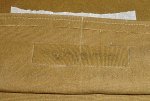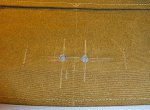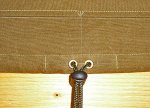N
Nomad
Guest
I recently scored a MkII Singer 201K in very good condition, sorted out a few bits that needed sorting, oiled it, and this seems to have rekindled my interest in sewing. After a few stuff sacks, I started looking at patterns with a view to making some sort of windproof top using some cotton that resulted from washing the oily stuff out of what was waxed cotton (see thread elsewhere). This wasn't the stuff with the gunk on it, but the other stuff that was originally too oily. A wash at 90° resulted in some nice medium weight olive green cotton that's substantially windproof.
After looking at one of the Green Pepper patterns (the Fairbanks anorak) and failing to find it in the UK, and being too tight to pay £20+ to order it from the US, I stumbled on Iain's recent video showing a blanket smock based on McCall's M5252, which looks to be a pattern for a fleece type jacket, which can also be made in a shell material, and has several style options - zip front or pullover, collar or hood, with or without arms. This looked like an easier pattern than the Fairbanks one (perhaps because this is unlined), so I decided to give it a go.
I've never made a garment before, and I've never made anything from a pattern, so this may or may not work out. For anyone in the same position who's thinking of trying something like this, I found this video helpful in understanding what's going on with patterns...
Quite long, but worth watching - she goes into plenty of detail and seems to cover everything.
Rather than sacrifice my pattern in the hope that it all fits, I decided to trace out all of the bits. After taking some measurements of myself and a jacket that I know is a tad too big, I reckoned size medium from the pattern should fit. I'm not 100% sure on some features yet, so I decided to trace all of the parts with no alterations.
The tracing was done on a roll of tracing paper 1m wide...

The white paper was taped to the table to give a light background, the pattern laid on top, and the tracing paper laid on top of that and taped down. Here are all of the bits after tracing and cutting out...

The tracing paper is quite stiff - much stiffer than the incredibly flimsy tissue paper that the pattern is printed on. I've tested it for pinning to fabric by making a stuff sack with a round bottom. It seems to work okay - doesn't warp when the pins go through it. It's also pretty curly (coming off a roll). Giving it a gentle iron under a bit of cloth with the iron set to Cool seems to help, although it still curls a bit.
I've still to decide on what style I want to go for, but it will be a pullover type with arms, Not sure yet on hood or collar. The pockets will change, probably to a kangaroo pocket at the top (the yoke-based design seems conducive to this), and a single wide pocket at the bottom. I think there will also be a drawstring at the hem, and Velcro tabs at the cuffs.
Next steps are to finalise the style and make any additional pattern pieces (pockets, and flap for top pocket), iron the cloth, and lay out the bits to see if there's enough. (I think there should be, but I'll check before I cut anything.) I also need to see if there are any notions to get, although I'm pretty well stocked for that sort of thing (might need to get zips if my metres of continuous coil zip doesn't look like what I want).
After looking at one of the Green Pepper patterns (the Fairbanks anorak) and failing to find it in the UK, and being too tight to pay £20+ to order it from the US, I stumbled on Iain's recent video showing a blanket smock based on McCall's M5252, which looks to be a pattern for a fleece type jacket, which can also be made in a shell material, and has several style options - zip front or pullover, collar or hood, with or without arms. This looked like an easier pattern than the Fairbanks one (perhaps because this is unlined), so I decided to give it a go.
I've never made a garment before, and I've never made anything from a pattern, so this may or may not work out. For anyone in the same position who's thinking of trying something like this, I found this video helpful in understanding what's going on with patterns...
Quite long, but worth watching - she goes into plenty of detail and seems to cover everything.
Rather than sacrifice my pattern in the hope that it all fits, I decided to trace out all of the bits. After taking some measurements of myself and a jacket that I know is a tad too big, I reckoned size medium from the pattern should fit. I'm not 100% sure on some features yet, so I decided to trace all of the parts with no alterations.
The tracing was done on a roll of tracing paper 1m wide...

The white paper was taped to the table to give a light background, the pattern laid on top, and the tracing paper laid on top of that and taped down. Here are all of the bits after tracing and cutting out...

The tracing paper is quite stiff - much stiffer than the incredibly flimsy tissue paper that the pattern is printed on. I've tested it for pinning to fabric by making a stuff sack with a round bottom. It seems to work okay - doesn't warp when the pins go through it. It's also pretty curly (coming off a roll). Giving it a gentle iron under a bit of cloth with the iron set to Cool seems to help, although it still curls a bit.
I've still to decide on what style I want to go for, but it will be a pullover type with arms, Not sure yet on hood or collar. The pockets will change, probably to a kangaroo pocket at the top (the yoke-based design seems conducive to this), and a single wide pocket at the bottom. I think there will also be a drawstring at the hem, and Velcro tabs at the cuffs.
Next steps are to finalise the style and make any additional pattern pieces (pockets, and flap for top pocket), iron the cloth, and lay out the bits to see if there's enough. (I think there should be, but I'll check before I cut anything.) I also need to see if there are any notions to get, although I'm pretty well stocked for that sort of thing (might need to get zips if my metres of continuous coil zip doesn't look like what I want).



